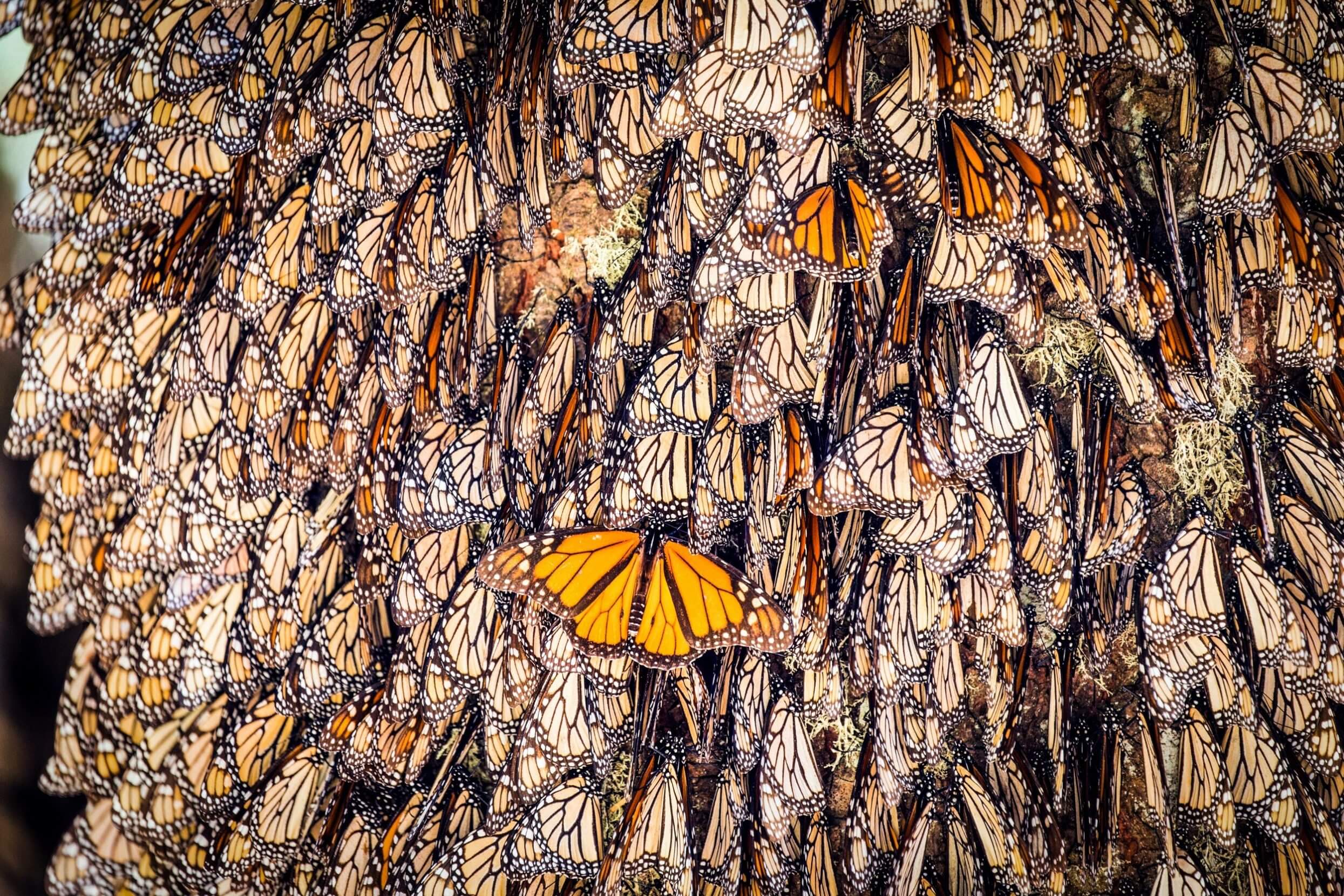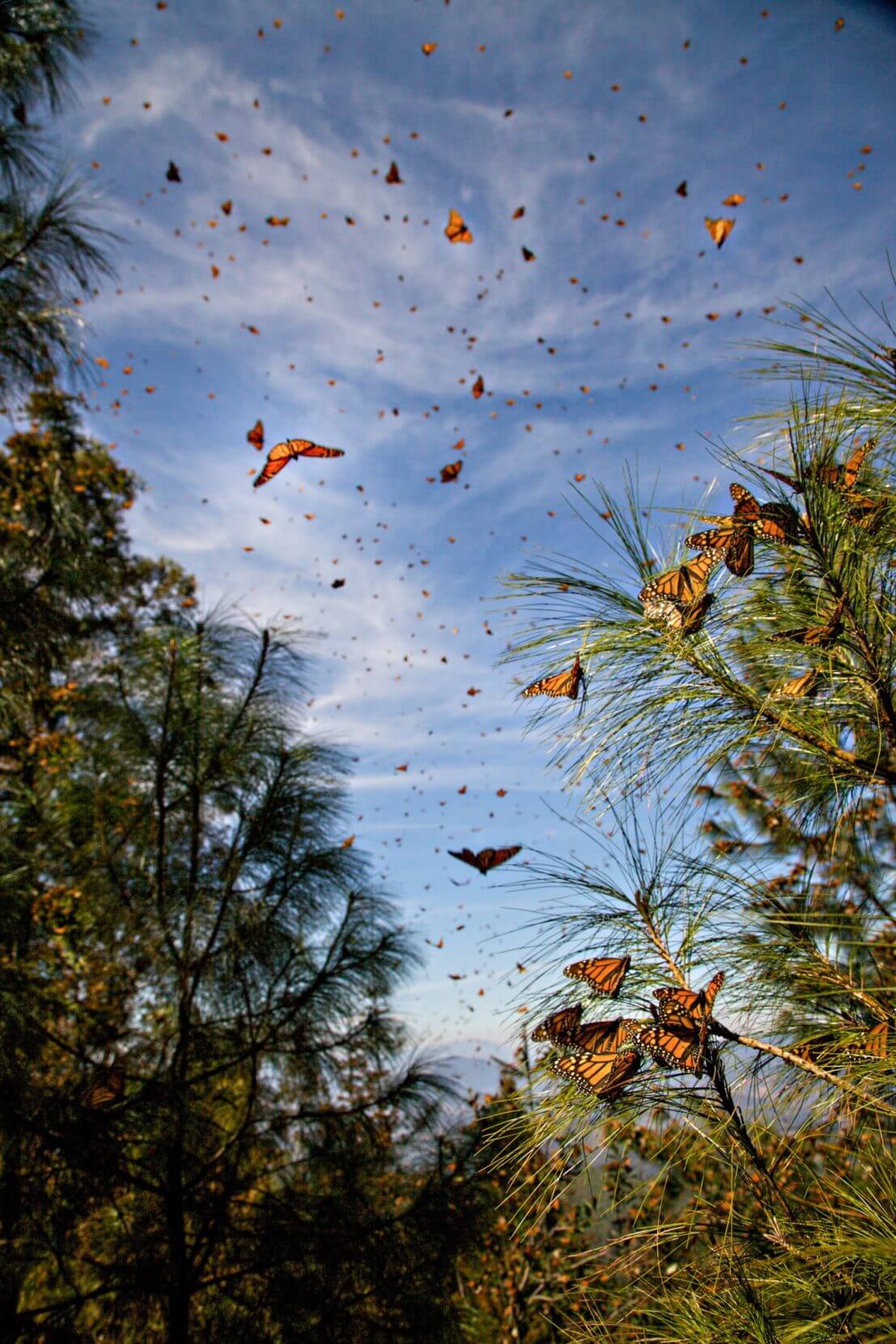Ariver of souls heads southward.
Like the millions of generations who came before, they make their way from territories northeast of the Great Lakes, and cascade down North America in wide, golden streams of motion. Members of the so-called “super-generation,” they’ll live up to eight times as long as their grandparents. This gives their tiny wings just enough time to carry them as far as 3,000 miles from where they started.
I myself have journeyed thousands of miles to this mountaintop in the sacred fir forests of the Trans-Mexican Volcanic Belt.

Near the village of Angangueo in Michoacán, Mexico, El Rosario Sanctuary waits for visitors from thousands of miles away. Photo: Chico Sanchez / Alamy
Here, in the monarch butterflies’ overwintering site in central Mexico, they come in waves.
Once they settle, the butterflies hang together like giant mango bunches, their wings closed tightly next to one another, feeling the unity and keeping warm after a transcendental journey that was charted by their distant ancestors.
I am familiar with the Western monarch butterfly population that overwinters in California, near my home a few hours north of Monterey. That monarch migration, however, is a small fraction of what I see in Mexico. Separated from their Western counterparts by the Rocky Mountains, migrating swarms of Eastern monarchs head south along the Sierra Madre Oriental range before settling into the mountains of the Trans-Mexican Volcanic Belt.
As they journey south, the monarchs catch wind currents to travel more than 50 miles in one day while sometimes flying more than two miles high. They navigate by comparing their inner biological “clocks” to the position of the sun, what scientists have dubbed an internal “time-compensated sun compass.” Every year, these remarkable navigators return to the same patch of trees deep in the mountains of Mexico. They are environmentally linked, as they have been for centuries, to this oyamel fir forest where the high altitude and ideal temperatures keep them cool and moist all winter.

After a 3,000-mile migration, Eastern Monarch butterflies cluster in the oyamel fir trees of Michoacán, Mexico’s Monarch Butterfly Biosphere Reserve, a UNESCO World Heritage Site. Photo: BIOSPHOTO / Alamy
When the migration is finished, hundreds of millions of monarch butterflies will reside in this relatively remote forest.
They have arrived at the beginning of November, just in time for Día de los Muertos — Day of the Dead. The villagers nearby in the town of Angangueo are waiting for the little visitors with altars filled with food, drinks, and photos of relatives. The Indigenous Purépecha believe the monarchs carry the souls of ancestors returning for a visit.
~~
Drawn to this floating dream of butterflies while visiting Mexico, I find a guide to lead me on an overnight tour to their winter refuge in the province of Michoacán. Though he lives in San Miguel de Allende, a city more than 125 miles away, Pablo Carrusco hosts weekly visits to the handful of sites in the 14,000-acre sanctuary during monarch season, which generally lasts from November through March. The Mexican government created the Monarch Butterfly Biosphere Reserve here in 1986, vowing to protect this natural habitat for future generations.
I meet Pablo early in the morning for the four-hour drive into the mountains.
“I’ve brought my daughter Amelie,” he says, smiling down at the lively seven-year-old. “She’s skipping school to go see the butterflies.”
Amelie clings to his side, bouncing up and down in her tennis shoes.
Pablo’s hair, pulled back in a ponytail, reveals a handsome, gentle face. He is in his late twenties, slim, and dressed in jeans. Father and daughter slide together into the front of the van to share the front seat with the driver. I watch from behind as Amelie, also in a ponytail, chatters to him in rapid Spanish and bumps her head against his, rubbing gently.
I’m suddenly eight years old… leading my mom and dad, my now-lost ancestors, by the hand.
Pablo has been visiting this reserve since a teacher brought him to the sanctuary in the third grade.
“The monarchs used to pass through our yard in Queretaro when I was a child,” he tells me, referring to his hometown 80 miles north of the sanctuary. “It was undeveloped then, a natural reserve, and hundreds of butterflies would spend the night in our yard. Later, I understood it was part of the migration.”
Like Pablo, I was introduced to the monarchs in my third-grade class. His memories triggering mine, I’m suddenly eight years old, carefully putting my burnt-orange crayon into an open candle flame to create a “melted Crayola” rendition of their striking black and orange patterns. Leading my mom and dad, my now-lost ancestors, by the hand through the art show, I bring them to the large, textured picture of two butterflies hovering above a blossoming yellow flower.
~~
Once in Michoacán, we pass through the small village of Angangueo, which sits above 8,000 feet, and continue a few miles uphill to a wooden sign proclaiming “El Rosario Biosphere Monarch Reserve.” Hundreds of butterflies hover above us as Amelie, excited, charges ahead.
The ascent is wondrous and steep, and my horse, “Fresca,” climbs straight up the 3,000-foot vertical slope before us. Clinging tightly to the oversized saddle horn as we rise into the coniferous forest, my fear changes quickly to wonder. Butterflies are gathering by the thousands on the surface of shallow pools created by a clear stream falling near the trail.
We dismount after just a quarter mile, disappointing my inner gaucho. The colonies are frequently farther into the forest, but this 2018-2019 season they aren’t far from the village. And it’s no wonder: The Comisión Nacional de Áreas Naturales Protegidas will soon report this year’s population size at more than six hectares. That’s less than historical monarch populations, but as a number that hasn’t been seen in over a decade, it represents a hopeful surge.
We are here at the warmest part of the day, which is when the butterflies take flight. The tall trees and the noon sun create columns of light strung together by a chord of gold and black shadows.
“Listen,” Pablo says, holding Amelie still in front of him. “You can hear their wings beating.”
I strain to hear the delicate sound in the hushed forest, but the wind carries it away.

Every year, millions of monarchs migrate from the United States and Canada, arriving in Mexico’s volcanic highlands for the winter. Because the butterflies arrive around el Día de los Muertos, the Indigenous Purépecha believe they carry the souls of ancestors. Photo: Richard Ellis / Alamy
~~
It’s irresistible to try to photograph the butterflies, despite the futility of capturing the erratic movements of their gossamer wings. We are told to be quiet, but it is an unnecessary reminder. We are awed into silence. The sheer number of monarchs is astonishing. They surround me, flying very close — by my shoulder, near my head, on my hand — and then, they are gone.
Butterflies are scattered everywhere beneath my feet, as weaker ones have made the long journey here but will go no further. Like oversized, orange-black bunches of leaves, they hang in dense clusters from the trees high above. The surrounding tree trunks are completely covered with golden wings. They fill the sunshine and shadows with thousands of quiet flights and hypnotizing patterns.
I stare up into the long columns of tall trees. I watch the butterfly kaleidoscope against a clear blue sky, mesmerized, and I’m overwhelmed with unknowing. Not just my own, like my ignorance of this majestic migration until only a month ago. It is deeper than myself. It is an awakening to how much humanity has yet to learn about nature’s mysteries that exist right in front of us. I feel strangely hopeful.
The quick, smooth undulations of flight repeat thousands of times in a 360-degree view around me. I could stay for days.
There is a time limit for visitors. But we overstay our designated half-hour by almost double, unable to tear ourselves away from the vision.
I watch the butterfly kaleidoscope against a clear blue sky, mesmerized, and I’m overwhelmed with unknowing.
A few hours later, we find refuge and time to savor the experience as we sit under a dark, starlit sky in the hot springs property where we will stay the night. Amelie flutters around the lush garden, her arms out like butterfly wings, and then plunges into the warm water beside me.
I watch Pablo and Amelie playing in the thermal spring, thinking about how he brings her each year on her birthday to witness this butterfly wonderland.
Lifting her high in the air, he throws her backward into the water. She swims back into his arms to be lifted and tossed up again, and again.
~~
A month later, when I return home, the image of millions of butterflies does not leave me. In the early spring rain, I kneel in the mud to plant milkweed seedlings around the edge of my garden.
A tough but lovely native wildflower, milkweed’s bitter taste protects monarchs at all life stages from predators. It allows them refuge as eggs, larvae, caterpillars, and lime-green chrysalises — so that they may emerge engineered for brilliant flight.
Milkweed habitat is decreasing, and with it, so is the monarch population. The remedy seems so simple and obvious: re-seed our dwindling fields and agricultural lands with more milkweed. But understanding, like the butterflies, comes in waves.
At first, we don’t see. But then, we notice. We awake, slowly.
~~
After a super-generation of monarchs has flown the long route south, it will take three to four generations to make the return trip home from Mexico. Each generation must work it out alone, following migratory patterns laid down over the millennia, navigating with genetics and instinct. Scientists have yet to fully understand this multi-generational migration.
I think of the generations of my own family, of the lessons we have learned that we cannot follow, but will relay to the next one. I think of my mom, who died last year at 96, leaving me alone after our entire long life together, flown away into the next life.
I imagine her as a butterfly, landing gently near me on a yellow flower.
Who’s to say souls can’t fly?
Martha Ezell
Martha Ezell is a freelance writer based in Petaluma, California. After careers in documentary filmmaking and academic technology, she now devotes her time to writing and travel.



